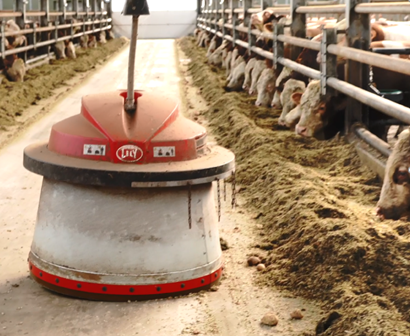The positive effects of feed pushing have been known for a long time in the field of dairy farming. Advantages of frequent feed pushing are increased herd activity, higher feed intake and better rumen health due to less pH fluctuations because of a more even feed intake. A narrow animal-to-feeding place-ratio led to the idea to implement this tool for fattening bulls, also. Fattening bulls can benefit from this technique. Besides the same advantages as mentioned for dairy cows, the animals are calmer due to less antagonistic behaviour at the feeding place.
Mechanisation is well advanced in the field of feed pushing and pushing can be fully automated. With automation, it is possible to work on the feed supply at night just as consistently as during the day. Behavioural studies report that cattle often eat alone or in pairs and extend their feeding behaviour over the full 24 hours of a day - this behaviour is fully accommodated by the automatic and continuous feed presentation. And even work peaks on the farm are no longer obstacles for a continuous feed supply.
 Feed pushing for fattening bulls (C) Zerbe
Feed pushing for fattening bulls (C) ZerbeA clear improvement in average daily gain gives credence to the automatic feed pushing, even if a feed pushing robot increases the costs and minor problems can lead to a full stop. The application in practical farms has shown that concentrates have only to be fed in the mixed ration and not when the feed is pushed on, in order to avoid rank fights. If fodder is always available, the animals do feed at night even as much as during the day. The feed intake is increased and this increases weight gain.
Literature:
- Heeren, R. (2019): Wer viel frisst….Kuh & Herde, das Magazin des Lely Center Niedersachen; Ausgabe Juni2019 https://www.lely.com/media/lely-centers-files/brochures/published/Kuh_und_Herde_Juni_2019_Website_zYkapXI.pdf
- Bonsels, T. (2020): Roboter schieben auch nach Feierabend. Eilbote 2020 https://www.eilbote-online.com/artikel/fuetterungstechnik-roboter-schieben-auch-nach-feierabend-36640
- Schneider L, Volkmann N, Kemper N and Spindler B (2020) Feeding Behavior of Fattening Bulls Fed Six Times per Day Using an Automatic Feeding System. Front. Vet. Sci. 7:43 https://www.frontiersin.org/articles/10.3389/fvets.2020.00043/full
This innovation has an impact on:
- Socio-economic resilience because of the costs for the equipment.
- Animal health and welfare because there is always feed available. This is positive for rumen pH and leads to less rank fighting at the feed bunk.
- Production efficiency and meat quality because the average daily growth is increased due to far more feed pushing intervals and this without an increase in labour time per animal.
- Environmental Sustainability because the increased daily growth shortens the duration of the fattening phase.